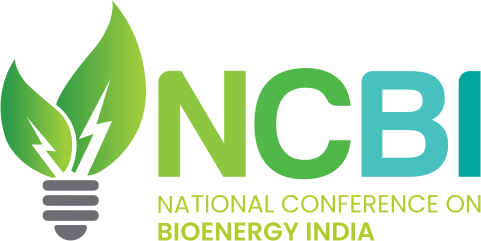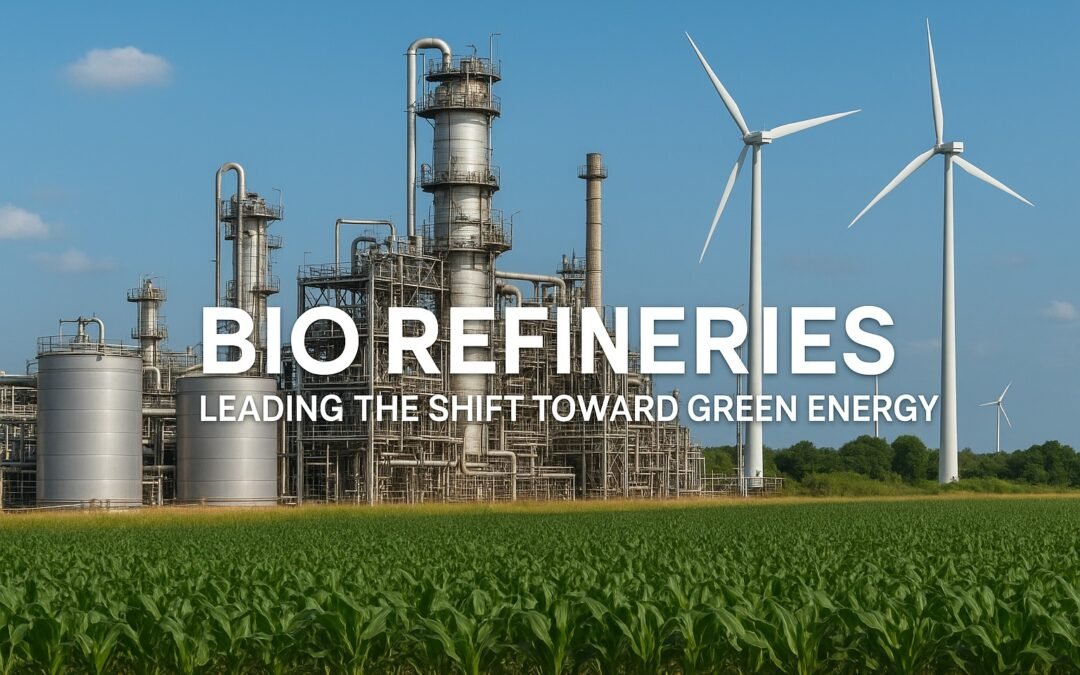Introduction
As the world faces the devastating consequences of climate change, the urgency to reduce our dependence on fossil fuels has never been greater. Renewable energy sources including biomass, hydropower, wind, and solar are becoming more and more popular. One of the most important and frequently overlooked contributions to the green revolution is being made by bio refineries. Bio Refineries are influencing the new energy paradigm for a cleaner, greener, and more sustainable world by turning organic biomass into fuels, power, heat, and chemicals.
One of the main participants in this movement is India. With its extensive agricultural and organic waste resources, as well as its ambitious renewable energy targets, the country is making impressive strides in the deployment of bio-refining infrastructure. The expanding significance of this industry is further highlighted by events like the India Green Energy Expo and the Green Energy India Expo 2025, which bring players together to speed up innovation, investment, and policy change.
This article explores the technologies, uses, difficulties, and crucial role that bio refineries will play in achieving carbon neutrality as well as how they are changing the energy landscape in India and around the world.
1. Understanding Bio Refineries
1.1 What Are Bio Refineries?
A bio refinery is a facility that uses renewable biological resources to create value-added chemicals, power, and fuels by integrating biomass conversion processes. Bio-refineries process organic materials like
- Rice husk, bagasse, and other agricultural leftovers
- Forest waste;
- Algae
- Animal waste
- Organic municipal solid waste, much like conventional refineries that process crude oil.
To create green energy products like bioethanol, biodiesel, biogas, and even bio-plastics, these materials are processed utilizing a mix of physical, thermal, chemical, and biological techniques.
1.2 Bio Refinery Types
The following categories apply to bio-refining technologies:
- Thermochemical (such as gasification and pyrolysis)
- Biochemical (such as fermentation and anaerobic digestion)
- Mechanical/physical (such as oil pressing and drying).
Each technique has a distinct function based on the final output and feedstock.
2: The Situation of Green Energy Worldwide
2.1 Energy Shifts and Climate Goals
Globally, countries are committing to ambitious climate agreements. According to IEA statistics, bioenergy, a substantial subgroup of renewable energy, is anticipated to supply around 30% of the world’s energy demands by 2050.
2.2 Biorefineries’ Place in the Energy Mix
Bio refineries are decentralizing energy production in addition to lessening reliance on fossil fuels. Bio-refineries can be placed close to industrial locations, metropolitan areas that generate organic waste, or rural areas, unlike solar or wind, which are location-dependent.
2.3 Key Takeaways from International Energy Summits
Bio-refining has been a recurring theme at international conferences and expos. These technologies will be emphasized as a key component of achieving Net Zero targets at the forthcoming Green Energy India Expo 2025 and the India Green Energy Expo.
3: The Indian Context of Bio Refineries
3.1 India’s Vision for Renewable Energy
India has pledged to attain net zero emissions by 2070 and 500 GW of non-fossil fuel energy capacity by 2030. Utilizing its organic waste and agricultural surplus through Bio Refineries is essential to achieving this.
3.2 Government Programs
- Compressed biogas via SATAT (Sustainable Alternative Towards Affordable Transportation).
- The 2018 National Policy on Biofuels, which addresses the development of bioethanol and biodiesel.
- Funding for waste-to-energy facilities and biomass pelletization.
3.3 Important Bio Refinery Initiatives in India
- The first bio-refinery in India to use bamboo is the Numaligarh Bio Refinery in Assam.
- The 2G ethanol plants owned by Indian Oil in Gujarat and Haryana.
- Praj Industries is a world-renowned company that offers complete bio-refinery solutions and has its headquarters in Pune.
The Green Energy India Expo 2025 will highlight India’s leadership in the bioeconomy by showcasing these facilities and technologies.
4: Conversion Technologies and Bio Refinery Feedstocks
4.1 The Availability of Feedstock in India
Every year, millions of tons of agricultural residue are produced in India. Sugarcane bagasse, rice husk, maize stover, wheat straw, municipal solid waste, and used cooking oil are examples of common feedstocks.
4.2 Technologies for Conversion
- Gasification: Biomass is transformed into syngas for fuel synthesis or power.
- Anaerobic Digestion: Biogas and biofertilizer are produced from organic waste.
- Fermentation: Bioethanol is produced by fermenting sugars.
- Transesterification: Biodiesel is produced from oils.
Although each technique has trade-offs in terms of efficiency and capital expenditure, they all support the ecosystem of biorefineries.
5: Biorefinery Applications
5.1 Fuels for Transportation
- Petrol is mixed with bioethanol.
- In logistics and agriculture, biodiesel is used in addition to diesel.
- Domestic cooking and transportation both use biogas, or CBG.
5.2 Heat and Power
Industries and rural communities are served by biomass combustion and biogas power plants. Decentralized power is essential for off-grid villages.
5.3 Bio-Based Substances
Additionally, bio refineries are making:
- Organic acids
- Bioplastics
- Cleaners
- Enzymes
- Resins
These substances lessen reliance on substitutes made from petroleum and are biodegradable.
6: Effects on the Economy and Environment
6.1 Waste Valorization and the Circular Economy
Bio-refineries turn waste into value. For example:
- Municipal waste → Biogas
- Bagasse → Bio-plastics
- Algae → Aviation biofuel
This contributes to a circular economy where waste streams from agriculture, forestry, and cities are reimagined as inputs for energy and material production.
6.2 Rural Empowerment and Job Creation
Bio-refining has been emphasized by the India Green Energy Expo as a source of employment in rural areas. Thousands of people are employed in this sector throughout the hinterlands of India, from feedstock collection to plant operations.
6.3 Reduction of Carbon
- Less landfill usage
- Cleaner air in rural regions where stubble is frequently burned
- CO₂ neutral or negative fuels
7: Bio Refineries vs. Other Green Energy Sources
| Feature | Bio Refineries | Solar | Wind |
| Base Load Power | ✅ Yes | ❌ No | ❌ No |
| Waste Utilization | ✅ Yes | ❌ No | ❌ No |
| Energy Storage | ✅ Biogas | ❌ Needs battery | ❌ Needs battery |
| Land Use | Moderate | High | High |
| Carbon Footprint | Low to Negative | Zero | Zero |
Bio-refining offers the unique ability to produce renewable fuels and manage organic waste, a critical advantage in densely populated countries like India
8: Developments in the Biorefinery Industry
8.1 Biofuel Made from Algae
Algae absorb CO₂ and grow quickly. It can make proteins, jet fuel, and biodiesel. Algae-based refineries are the focus of several R&D startups in India.
8.2 Integration of Carbon Capture
CO2 emissions are being captured by next-generation bio-refineries, which then either turn them into bioplastics or feed them to greenhouses for crop growth.
8.3 Automation and AI
AI is increasing Bio Refineries’ efficiency and traceability in a variety of ways, from feedstock analytics to plant automation. Investors and business executives will be drawn to see these innovations on exhibit at the Green Energy India Expo in 2025.
9: Difficulties and Obstacles
9.1 Exorbitant Capital Expenses
Establishing a biorefinery might cost many crores, particularly for gasification or second-generation ethanol plants.
9.2 Uncertainty in Policy
Despite the existence of policies, investor trust is hampered by their frequent revisions and lax enforcement.
9.3 Supply Chains for Feedstock
Feedstock logistics are complicated by seasonal availability, moisture content, and transportation issues.
9.4 Awareness of the Public
The potential for bioenergy and waste segregation are still not well understood by farmers and the general public.
10: Outlook for the Indian and Global Industries
10.1 Forecasts for Market Growth
- Industry projections state that by 2030, the worldwide bio-refinery market is anticipated to grow to a value of over $950 billion.
- From 2025 to 2030, the bioenergy market in India is anticipated to expand at a compound annual growth rate (CAGR) of 14%.
10.2 Prospects for Exporting
India has the potential to sell small-scale biorefinery technology to developing countries, particularly those in Asia and Africa.
11: Green Energy India Expo 2025 Highlights
11.1 What to Expect
Asia’s largest venues for bio-refinery technology launches, roundtables on industry-government collaboration, green financing opportunities, and startup pitch competitions for sustainable innovations are expected to be the Green Energy India Expo 2025 and India Green Energy Expo.
11.2 Involvement of Industry
In order to further India’s bioenergy objective, leaders such as Indian Oil, Praj Industries, HPCL, and worldwide biofuel consortiums are anticipated to exhibit at the expo.
Final Thought
Bio refineries have the potential to revolutionize the energy, ecology, and economy in addition to providing a remedy for the reliance on fossil fuels. They hold the key to a truly sustainable future, from decentralizing power and creating green jobs to controlling waste and enhancing air quality.
India is poised for a bioenergy revolution thanks to its abundant biomass resources, creative entrepreneurs, and supportive policies. This shift will only accelerate with events like the India Green Energy Expo 2025 and India Green Energy Expo, which will attract investors, innovators, and policymakers to a more environmentally friendly future.
Bio Refineries, which are based on sustainability and driven by innovation, provide a clear way ahead as we stand at the intersection of technological potential and environmental disaster.




